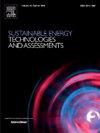Assessment and optimization of SF6 recovery from SF6/N2 mixture via temperature swing adsorption cycle
IF 7.1
2区 工程技术
Q1 ENERGY & FUELS
Sustainable Energy Technologies and Assessments
Pub Date : 2025-04-01
DOI:10.1016/j.seta.2025.104288
引用次数: 0
Abstract
Sulfur hexafluoride (SF6) is a powerful greenhouse gas. However, the existing studies primarily employ the pressure swing adsorption cycle or vacuum swing adsorption cycle for SF6 recovery and tend to focus on a single performance indicator, thereby lacking a comprehensive assessment of the adsorption cycle across multiple dimensions. In this paper, the temperature swing adsorption (TSA) cycle model is constructed. Six performance indicators are selected for sensitivity analysis. A comprehensive assessment of SF6 recovery using TSA cycle is conducted, focusing on the dimensions of production, separation, and energy efficiency. The multi-objective optimization is further performed. The aim of this work is to explore the feasibility of recycling SF6 via the TSA cycle. Results indicate that the Toth model demonstrates the superior fit with R2 of 0.9991. There is a positive correlation between the recovery and the purity, while the exergy efficiency displays a competitive relationship with recovery and the purity. Based on the TOPSIS decision-making method, the optimal values for the adsorption temperature and desorption temperature are found to be 293.00 K and 373.56 K, respectively. Under this operating condition, the recovery, purity, and exergy efficiency are achieved at 86.13 %, 98.69 %, and 2.70 %, respectively.

变温吸附循环从SF6/N2混合物中回收SF6的评价与优化
六氟化硫(SF6)是一种强大的温室气体。然而,现有研究主要采用变压吸附循环或真空变压吸附循环回收SF6,且往往侧重于单一的性能指标,缺乏对吸附循环进行多维度的综合评估。本文建立了变温吸附(TSA)循环模型。选取6个绩效指标进行敏感性分析。对利用TSA循环回收SF6进行了综合评估,重点从生产、分离和能源效率三个方面进行了评估。进一步进行了多目标优化。本研究的目的是探讨通过TSA循环回收SF6的可行性。结果表明,Toth模型拟合较好,R2为0.9991。回收率与纯度呈正相关,而火用效率与回收率、纯度呈竞争关系。基于TOPSIS决策方法,优选出吸附温度为293.00 K,解吸温度为373.56 K。在此操作条件下,回收率为86.13%,纯度为98.69%,火用效率为2.70%。
本文章由计算机程序翻译,如有差异,请以英文原文为准。
求助全文
约1分钟内获得全文
求助全文
来源期刊

Sustainable Energy Technologies and Assessments
Energy-Renewable Energy, Sustainability and the Environment
CiteScore
12.70
自引率
12.50%
发文量
1091
期刊介绍:
Encouraging a transition to a sustainable energy future is imperative for our world. Technologies that enable this shift in various sectors like transportation, heating, and power systems are of utmost importance. Sustainable Energy Technologies and Assessments welcomes papers focusing on a range of aspects and levels of technological advancements in energy generation and utilization. The aim is to reduce the negative environmental impact associated with energy production and consumption, spanning from laboratory experiments to real-world applications in the commercial sector.
 求助内容:
求助内容: 应助结果提醒方式:
应助结果提醒方式:


